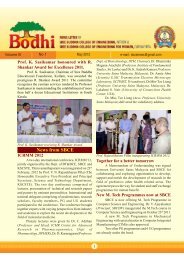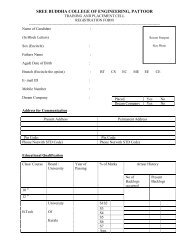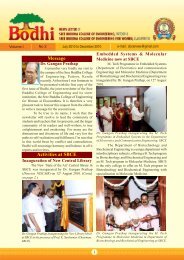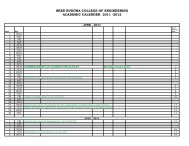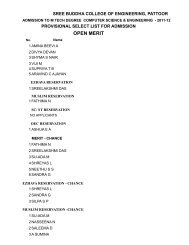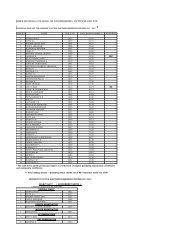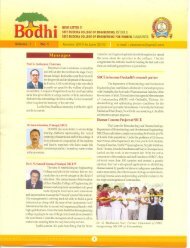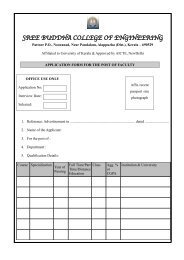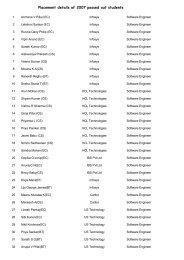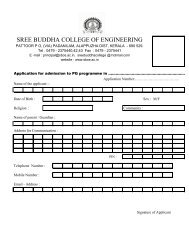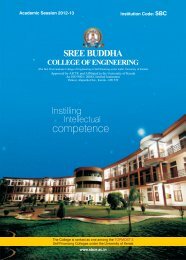UNIVERSITY OF KERALA
UNIVERSITY OF KERALA
UNIVERSITY OF KERALA
You also want an ePaper? Increase the reach of your titles
YUMPU automatically turns print PDFs into web optimized ePapers that Google loves.
MODULE III<br />
Mechanical Power transmission systems: Belt, rope and gear drives-types, comparison and fields of application-velocity ratioslip<br />
(simple problems) friction disc, single plate clutch, gear trains (no derivations).<br />
Manufacturing processes: Elementary ideas of casting, forging, rolling, welding, soldering and brazing<br />
Machining processes- turning, taper turning, thread cutting, shaping, drilling, grinding, milling (simple sketches and short notes).<br />
Non conventional machining - Electro discharge machining (EDM) and Electro chemical machining (ECM)<br />
Principle, application and advantages of C N C machine<br />
REFERENCES<br />
1. Spalding and Cole, Engineering Thermodynamic, Arnold<br />
2. Gill, Smith and Zuirys, Fundamentals of IC Engine, Oxford<br />
3. Amstead, Ostwald and Begeman, Manufacturing processes, Wiley<br />
4. Crouse, Automobile Engineering, Mc Graw Hill<br />
5. Roy and Choudhary, Elements of Mechanical Engineering<br />
6. Hajra Choudhary, Workshop Technology<br />
7. R K Bensal, Fluid mechanics and machines<br />
8. J Benjamin, Basic Mechanical Engineering, Zenith Publications, Kollam<br />
Note: Lectures are to be supplemented by demonstration in laboratories.<br />
Note: The question paper will consist of two parts. Part I is to be compulsory for 40 marks. This may contain 10 questions of 4<br />
marks each. Part II is to cover 3 modules. There can be 3 questions from each module (10 marks each) out of which 2 are to be<br />
answered.<br />
08.108 BASIC ELECTRICAL AND ELECTRONICS ENGINEERING<br />
Credits: 6<br />
L/T/P:2/1/0<br />
MODULE I<br />
Elementary concepts - Kirchoffs laws - Magnetic Circuits - MMF, field strength, flux density, reluctance – problems<br />
in series magnetic circuits. Review of electromagnetic induction - Faradays laws, Lenz's law - statically induced and<br />
dynamically induced emf - self and mutual induction - inductance.<br />
Alternating current fundamentals - generation of alternating currents – waveforms - frequency - period - average and<br />
rms values - form factor. Phasor representation of alternating quantities - rectangular polar and exponential forms.<br />
Analysis of simple ac circuits – concept of impedance and admittance - phasor representation - j notation - power and<br />
power factor in ac circuits - active and reactive components. Solution of RL, RC and RLC series circuits.<br />
Three phase systems - generation of three phase voltage - star and delta connection - relation between phase and line<br />
values of voltage and current - phasor representation - three wire and four wire systems.<br />
Measurement of power in three phase circuits ( two wattmeter method). Measurement of energy – working of 1-phase<br />
energy meter.<br />
MODULE II<br />
Transformers - Principle of operation - EMF equation - constructional details of single phase and three phase<br />
transformers<br />
Methods of bulk generation of electric power. Block schematic of layout of generating stations - hydroelectric, thermal<br />
and nuclear power plants. Renewable energy sources - solar, wind, tidal, wave and geothermal energy.<br />
Bulk transmission of electric power - typical electrical power transmission scheme - need for high transmission voltage<br />
- substations - substation equipments. Primary and secondary transmission and distribution systems<br />
Different methods of wiring for LT installations. Schematic layout of LT switchboards. Earthing of installations -<br />
necessity of earthing - plate and pipe earthing. Protective fuses, MCBs, ELCBs and switches.<br />
Working of incandescent lamps, -fluorescent lamps, energy efficient lamps<br />
MODULE III<br />
Diodes - PN junction diodes,. V-I characteristics, dynamic & static resistance, principle of working and V-I<br />
characteristics of Zener diode, principle of Photo diode, Solar cell, & LED. Rectifiers & power supplies - block<br />
diagram description of a dc power supply, circuit diagram & working of half-wave & full wave rectifier, final<br />
equations of Vrms, Vdc, ripple factor and peak inverse voltage in each case, principle of<br />
18



